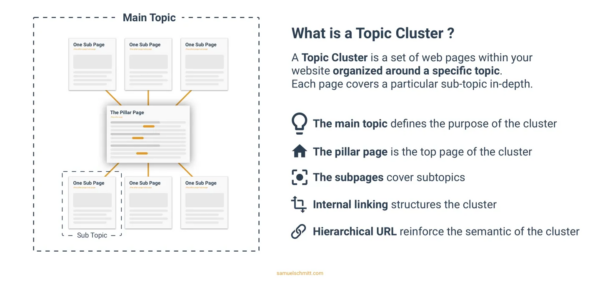If you’ve been writing blog posts for your online business or shop website for a while now but aren’t seeing the organic traffic growth you had hoped for, then you may be missing a trick.
There are many different ways and SEO tactics that you can implement to help you increase your organic traffic. One of the better ways to do this and one that most large businesses and marketers are using is by creating Cluster Content.
Cluster content is where you choose a primary topic relating to your business, for example, for EKM our main cluster topic is ‘ecommerce’, and you then create a cluster of content around that topic. Of course, it’s not just random content ideas you want, but targeted and thought out SEO focused content.

This example gives you a better idea visually of what the cluster content method is. The idea is that the content is organised in a particular way via your blog navigation and internal linking so that search engines like Google can crawl your content easier and see that each piece is related to one another.
This new method is being used by many businesses, and this came about because of how Google changed its algorithm to favour topic-based content.
How to get started with your own cluster content
Before you jump into researching and writing your blog content, you’ll need to think about if this method is right for your business. You can start by asking yourself:
- Does the topic you’d want to rank for having enough search volume to be worth the time and effort?
- Do you perhaps already have content covering the topic? Can it be optimised and used within your cluster content or simply added via internal links?
- Is the topic in mind something you can cover in detail? You’ll more than likely need to write a lot of content to the point you’re going into fine detail with some of your content.
If you can answer these initial questions then you’ll have a great starting point for your cluster content.
Map out your clusters
The next steps you’ll need to take are to map out your cluster content through a simple process.
Firstly, note down 5-10 problems your ideal customer has and group these problems into broad topic areas. You’ll then want to do a little keyword research to build out each of your topic areas with more content. You’ll want to choose keywords that have a high volume but aren’t too hard to rank for.
Next up, is making sure the content you’re creating is validated by looking at your competitors content, seeing what they do and what ranks well already for your keywords. Finally, map out how your content cluster is going to work and what it’s going to look like, using your blog’s navigation and internal linking structure.
This may come with some additional work to ensure that both your blog and navigation structure can accommodate your new cluster content strategy.
Create and measure
Finally, now you’ve done all your research and preparation work you can get started with creating the content for your first cluster. Make sure that you’re following the current SEO best practices including, word count, keyword research for each piece, making sure all your alt tags are completed and you’ve got a nice mix of internal and external linking throughout.
You can rinse and repeat this process for a few different topic clusters as long as it’s highly relevant to your website or business. Try making sure you’re answering every question your customers are asking.
But in order to see if your strategy is working, you’ll need to analyse and measure your impact. This can include seeing if you’ve got an uplift in traffic coming through your blog’s cluster content. If any of those cluster pages are helping you get conversions, and if any of them are being ranked highly for their chosen keyword.
Remember to keep optimising content where necessary and update any blogs that are date specific so your readers always have access to the best and freshest content.
Digital & Social Articles on Business 2 Community
(51)







